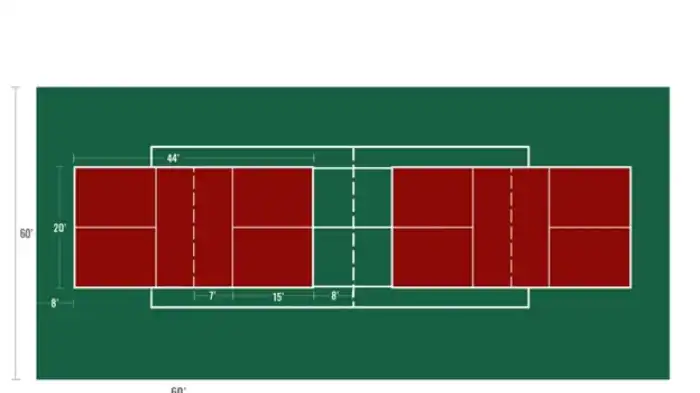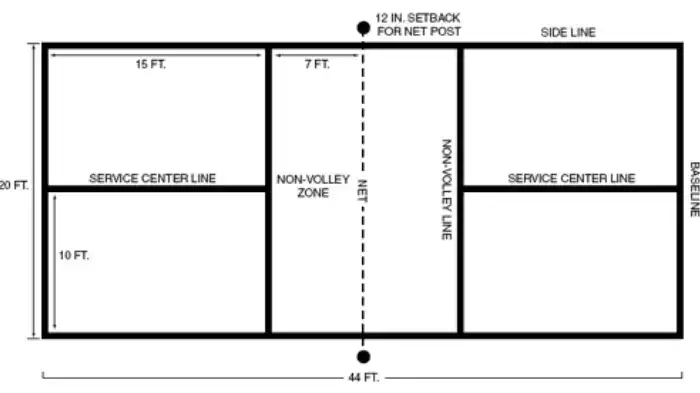Pickleball is a popular racquet sport that combines elements of tennis, badminton, and table tennis. It is played on a court that has distinct lines and dimensions. Understanding the pickleball court layout is essential for players to enjoy the game and follow the rules properly. In this blog, we will explore the different components of pickleball court layout and their significance.
Court Dimensions
Before diving into the details, let’s discuss the overall dimensions of a Pickleball Court Layout. The court is rectangular in shape, measuring 20 feet wide and 44 feet long for doubles play. For singles play, the court is reduced to 20 feet wide and 22 feet long.

Baselines
The baselines are the lines at the back of the court. They run parallel to the net and are 22 feet apart for doubles play, while for singles play, they are located at the very back and extend the full width of the court, 20 feet apart. The server must stand behind the baseline and hit the ball diagonally over the net into the service area on the opposite side.
Centerline and Non-Volley Zone
The centerline divides the court into two equal halves, separating the two sides for each player or team. Another important feature is the non-volley zone, also known as the “kitchen.” It is a seven-foot area on both sides of the net, starting from the net and extending into the court. Players are not allowed to step into the kitchen and hit volley shots from there unless the ball bounces first.
Service Courts and Lines
Pickleball has specific service courts for both doubles and singles play. In doubles, there are two service courts on each side of the net. These courts are further divided into two sections by the centerline. The service area is where the serve must land within, diagonally on the opposite side of the court. The serving team’s score determines which side of the service court they should serve from.
Court Markings and Lines
Pickleball courts have various markings and lines that help define different areas and boundaries within the court. These lines determine whether a shot is in or out, as well as guiding player movement.
Sidelines
The sidelines run parallel to the net and define the width of the court. All shots must land within the sidelines to be considered in play. If the ball lands outside the sidelines, it is considered out of bounds.
Baseline and Non-Volley Zone Lines
The baseline and non-volley zone lines mark the extent of the baseline and the non-volley zone, respectively. These lines are crucial for player positioning and determining fault during a serve.
Service Court Lines
Within the service courts, there are two important lines or marks. The first one is the service centerline, which splits the service court in half for both teams. The second is the service side line, which determines the in-bounds area for the serve.

Conclusion
Understanding the pickleball court layout is essential for any player looking to enjoy the game and compete competitively. By familiarizing yourself with the different dimensions, lines, and zones, you can better position yourself and execute strategic shots. Whether you are a beginner or a seasoned player, knowing the court layout will enhance your pickleball experience.
Frequently Asked Questions
The standard size of a pickleball court is 20 feet wide and 44 feet long, with a non-volley zone (kitchen) extending 7 feet from the net on both sides.
Yes, pickleball courts can be adjusted to fit smaller spaces. It is possible to create smaller courts by reducing the width or length, as long as the proportions are maintained. However, it is important to note that official tournaments and league play may require standard-sized courts.
Yes, pickleball courts can be designed for indoor play. Indoor pickleball courts usually follow the same dimensions as outdoor courts. However, it’s important to ensure proper flooring and lighting to create a safe and enjoyable playing environment.
No, the pickleball net should not be placed in the center of the court. The net should be positioned slightly off center, with the center strap directly above the centerline. This allows for an equal amount of playing space on both sides of the net.
Yes, pickleball courts have specific markings and lines. The court is divided into two equal halves by a centerline, and each half is further divided into three sections. The non-volley zone (kitchen) is marked by a line, extending 7 feet from the net on both sides. Additionally, there are boundary lines along the sides and back of the court to indicate out-of-bounds areas.

